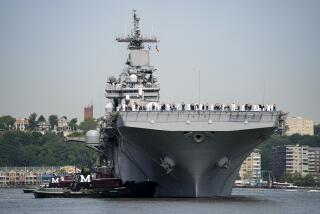A Sea Change Is Afloat in Navy as U.S. Destroyer Deploys to Gulf
- Share via
FREMANTLE, Australia — With a new crew and some fresh paint, the U.S. destroyer Fletcher left this Indian Ocean port Sunday -- bound to make its mark on the Persian Gulf and Navy history.
The vessel, capable of launching Tomahawk missiles, is part of a culture-busting experiment by the Navy to see whether the sea service can overcome a modern dilemma by dropping an old tradition: that a crew stays with its ship.
With barely half the vessels it had at one point in the Reagan administration, the Navy has struggled to maintain an adequate number around the globe, particularly during times of high tension like the showdown with Iraq.
For years, analysts have suggested keeping ships “on station” longer and flying in fresh crews from the U.S. to relieve sailors who had served their six-month deployment. But the Navy resisted.
A key way that the Navy instills pride and teamwork in its sailors -- many of them young, away from home for the first time and assigned to arduous tasks -- is to encourage them to feel a proprietary interest in “their” ship and assume responsibility for its well-being from the moment it leaves home port to the day it returns.
In addition, there has been a belief among Navy brass that a crew needs a long transit -- like the roughly 35-day trip from San Diego to the Persian Gulf -- to learn a vessel’s idiosyncrasies and be able to “fight the ship” if it is ordered into combat.
Now, in an experiment called Sea Swap, the Navy is testing whether those long-held views are valid.
“Clearly, this is not your father’s Navy,” said David Zvijac, a consultant with the Center for Naval Analyses in Alexandria, Va., which was hired by the Navy to evaluate Sea Swap. “This is a very different way of doing business. The Navy realizes that something has to give.”
The Fletcher arrived in Fremantle two weeks ago after five months in the Persian Gulf enforcing U.N. economic sanctions meant to force Iraqi President Saddam Hussein into relinquishing any weapons of mass destruction.
In normal times, the Fletcher would return to its home port of Pearl Harbor, where the crew would go on liberty and the ship would undergo repairs before its next deployment. But these are not normal times.
So a new crew was flown here from San Diego -- 350 sailors whose last ship, the destroyer Kinkaid, was recently decommissioned.
After a transition period, “Team Kinkaid” is now returning the Fletcher to the Persian Gulf and its mission of looking for Iraqi smugglers and possible terrorists.
Both crews received liberty in an area with abundant tourist attractions and an economy that favors the U.S. dollar.
And the Navy will get more mileage, in effect, from its ship, overcoming the “tyranny of distance” that can decrease by more than 50% the on-station time of a vessel during a normal 182-day deployment.
“This is a cultural shift for the Navy,” said Adm. Walter Doran, commander of the Pacific Fleet. “As an old black-shoe sailor” -- one assigned to surface ships -- “it feels strange. But I’m convinced it’s the right thing to do.”
In six months, the Fletcher will dock at a foreign port and get another fresh crew -- from the San Diego-based destroyer Oldendorf. When that happens, Team Kinkaid will enjoy liberty in the as-yet-undetermined spot and then fly to San Diego.
The Fletcher, Kinkaid and Oldendorf are Spruance-class destroyers and share similar technology and weapons systems.
Cmdr. Chuck Gaouette of the Oldendorf, which is also slated for decommissioning, likens the swap to “riding a horse at full gallop, jumping off onto another horse at full gallop and riding it into battle.”
A similar swap is underway with three crews from a different class of destroyers.
Though such swaps have been done for submarines and minesweepers, this is the first time that they have been tried on a larger-scale surface ship.
Officers say they’ll look for any sign of a drop in morale or sagging combat readiness among the new crew. Kinkaid crew members were given hats with “USS Fletcher” on the bill and “Team Kinkaid” on the side.
“We’ll put the Kinkaid personality on the Fletcher hull,” said Lt. Cmdr. Bill Seaman, the ship’s new executive officer.
Although it is too soon to tell, Sea Swap may show that tradition appeals less to young naval personnel than to their seniors.
“A ship is a thing,” said Petty Officer 3rd Class Jamaine Atkins, a Team Kinkaid member. “What’s important about a ship is its sailors, particularly the enlisted sailors. We’re the ones who make the ship work.”
If the Navy has yet to determine whether Sea Swap is a success, tourism officials in Fremantle and nearby Perth have no such doubts. Local authorities have already begun negotiating with the Navy to make the area into a permanent Sea Swap city.
Although the presence of the Fletcher increased the anger of Australians who feel their country is too aligned with the U.S. on military matters, tourism officials note that the sailors spent twice as much per day as the average tourist.
Loren Thompson, a defense analyst with the Lexington Institute think tank in Arlington, Va., said the Navy “deserves credit for breaking with tradition.” But he added his concern that, in Congress, Sea Swap could be “the latest excuse for deferring investment in a fleet big enough and modern enough to patrol the globe.”
Ivan Eland, an analyst with the Cato Institute think tank in Washington, said Sea Swap could “increase the abysmal efficiency of Navy deployments” and reduce the “back and forth from American ports to distant spots that wears out ships and personnel needlessly.”
Seaman Taurean James, a Fletcher crew member waiting to return home, is less interested in big-picture concerns than in his liberty in Australia. The Navy and the Australian Department of Defense have provided the former Fletcher crew with free lodging, meals, recreational facilities and Internet connections
“Even before I joined the Navy, I heard about Perth being a great spot,” James said. “Now I’ve seen it.”
More to Read
Sign up for Essential California
The most important California stories and recommendations in your inbox every morning.
You may occasionally receive promotional content from the Los Angeles Times.












